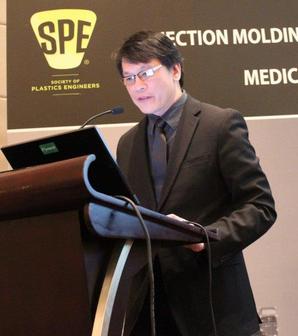Rebecca Kanthor
PLASTICS NEWS CORRESPONDENT
Published: December 26, 2013 7:56 am ET
Updated: December 26, 2013 8:12 am ET

Image By: Rebecca Kanthor
David Kusuma
SHANGHAI — When many consumers think of plastic, Tupperware comes to mind. Thanks to the company's direct sales strategy, the famously kitschy Tupperware parties that were popular in the 1950s and still go on today; perhaps no plastic brand occupies a bigger place in American pop culture.
But Tupperware's design team is not stuck in the past. David Kusuma, vice president of design at Tupperware Brands Corp., says the company's innovation continues.
Speaking at the Society of Plastics Engineers' first China conference, held Dec. 11-12 in Shanghai, Kusuma shared with attendees how Tupperware is experimenting with plastics as it looks to the future.
"Plastic as a material remains Tupperware's focus," Kusuma told Plastics News in an interview after his talk. "Plastics is one of the most versatile materials. You can go from soft to hard, from high temperature to low temperature. I mean, it has a wide range of possibilities."
He said the company is not out searching for new materials. "We look more at the product solution and the material is part of that in order to solve that problem."
Pressure from consumers and exciting new innovations have led the company to look into bio-based plastics. Tupperware has launched several biomaterial products in the past to test the market.
"They've all been well received," Kusuma said. "We have a consumer base that is very much expecting us to go into this area."
But he added that the company is not completely sold on biomaterials.
"I should mention," he continued, "that in life-cycle assessments that we have done, some also point to the fact that not all biopolymers are necessarily earth-friendly. … It turns out its carbon footprint could be higher than other raw materials. So you really have to look at it one at a time."
Speaking of environmental issues, Kusuma challenged the perception that plastics are bad for the environment.
"We consider ourselves to already be very environmentally friendly because our products are designed for long use. We've even done lifecycle assessments on our products vs. limited life products, and there is a really big difference in less use of energy [and] less carbon footprint," he said.
Tupperware products are known for their durability, and Kusuma said customers pass down their sets from generation to generation. In some markets, Tupperware products have a lifetime warranty.
The company has done well developing products for specific local markets, he said, including kimchi containers in Korea, kimono keepers in Japan, and masala containers in India.
One example of a highly successful product Tupperware launched was cheese containers. The containers featured a semi-permeable membrane that helped manage the moisture content of the cheese in a refrigerated state.
"The science is very simple," Kusuma said. "It is basically moving moisture from an area of high vapor pressure to an area of low vapor pressure," But simple science translated into big sales. "It quickly became the No. 1 product in Europe, our most mature market at the time, for a while," he said.
As for current projects, Kusuma remained coy. "I'm excited about a lot of things. Can't talk about many — that's the problem." He did mention that Tupperware is currently working on projects requiring material solutions and multi-component molding.
In his presentation to conference attendees, he gave a peek behind the scenes to share several projects that the R&D team is researching. Each was related to the four strategic target issues for consumers that the company has identified to help focus the company's design direction: health, organization, money, and environment.
One research project that piqued the interest of attendees was how to apply the lotus effect in plastics. The lotus flower leaf has self-cleaning and water-repelling capabilities that have long fascinated researchers, including those working on plastic applications. Kusuma said the idea of self-cleaning kitchenware is alluring, but he is unsure about the quality of the results.
"You can achieve it provided that you like the results," he said. "You have to qualify it. You heard questions of durability, it is a big issue." He shared the example at the conference to see if others were working on the same problem. Judging from the audience response, there were more than a few.
"It's one of the interesting topics, but there are so many of them and there are a lot more innovative things that are a lot more real," he said.
He said Tupperware aims for a 50 percent success rate in projects at the R&D stage.
"We have a very detailed R&D strategy and we just tackle it one year at a time," Kusuma said. | 